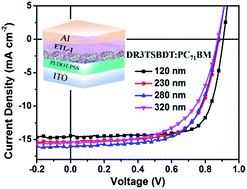Large active layer thickness toleration of high-efficiency small molecule solar cells†
Abstract
High-efficiency organic solar cells with large active layer thickness toleration are in high demand to meet the challenges in feasible commercial production on a large scale. Generally, devices with thick active layers are preferred because they allow both the formation of a more uniform film and the effective utilization of incident light. In this work, solar cell devices with layer thicknesses ranging from 65 to 370 nm based on a small molecule donor DR3TSBDT and electron acceptor PC71BM were fabricated and the thickness dependence of the photovoltaic performance was systematically studied. High power conversion efficiencies (PCEs) were well-maintained in a wide layer thickness range, and for devices with layer thicknesses of 280 and 370 nm, PCEs that were off by only ∼8% and 20%, respectively, from the best PCE value of 9.95% at 120 nm were achieved. With systematic investigations, the well-maintained high performance is attributed to the fact that both the nearly ideal morphology (a bi-continuous interpenetrating crystalline nano-fibrillar structure) of the active layer and the hole mobility remained largely unchanged over the wide thickness range. Also as expected, with increasing thickness, larger transport resistance, charge recombination and transit times were observed, which made the fill factor lower. But these inferior factors were largely compensated by the increased current, and thus well-maintained high performance was achieved.



 Please wait while we load your content...
Please wait while we load your content...